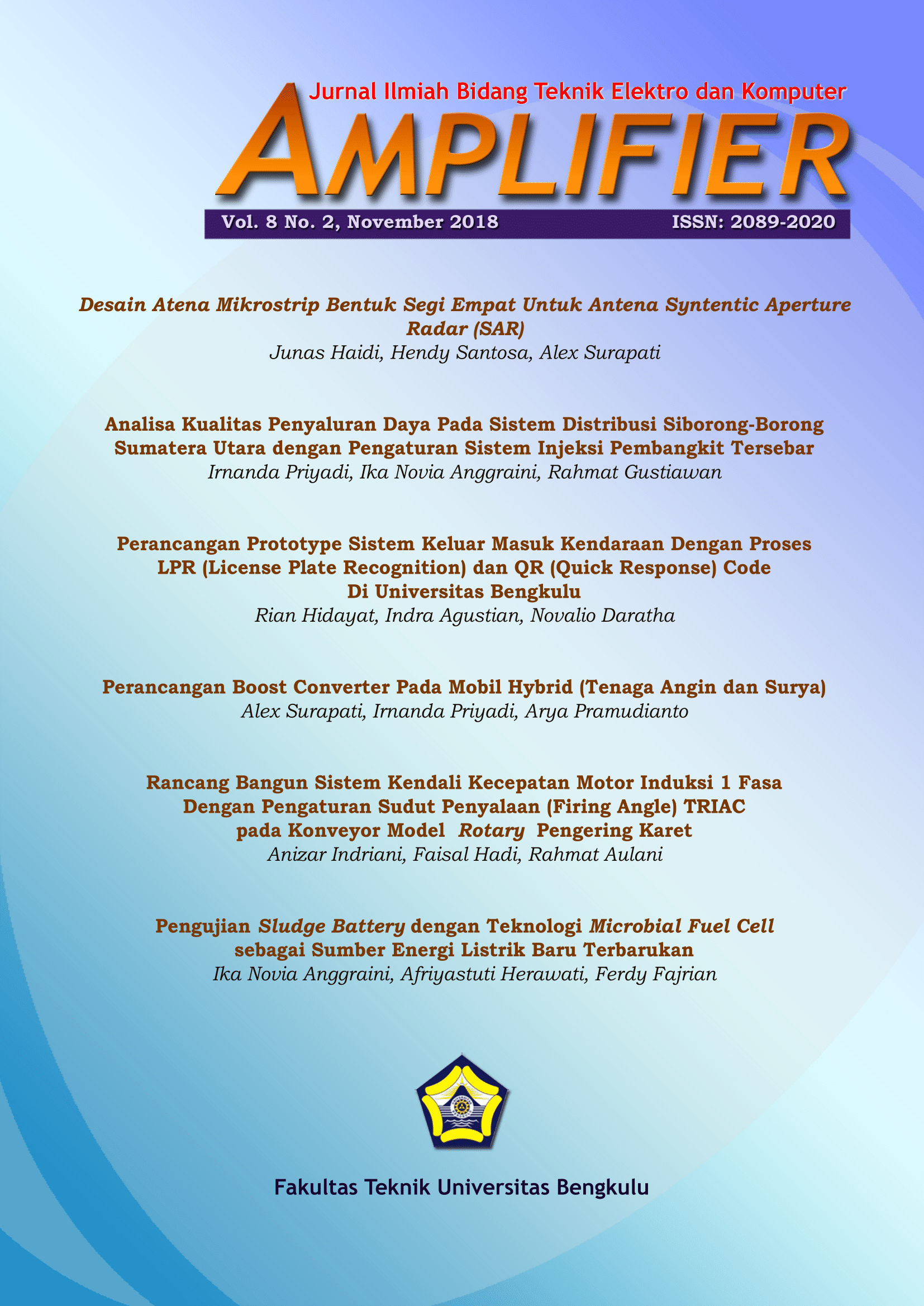Main Article Content
Abstract
ABSTRACT
Microbial Fuel Cells are devices which convert chemical energy into electrical energy through catalytic reactions by microorganisms. In this study, the potential of electricity in MFC will be analyzed by using samples of sea mud, lake mud, land mud, and river mud. While the method used in this study is one series connected vessel, two vessels connected series with mud-water, two mud-mud series vessels, and the stack series method. The highest electrical conductivity produced by river mud reaches 3.63 mS/cm, while the lowest is lake mud with a conductivity value of 0.35 mS/cm. The highest electric power density produced by river mud by the two mud-mud vessel method is 46.766 mW/m2, while the lowest electrical power density in lake mud is 18.040 mW/m2. The highest electrical power is produced by river mud through a single vessel series system with a maximum power of 7.26 mW, while the lowest power is found in marine mud with a system of two mud-water vessels which is equal to 0.30 mW. The pattern of increase in voltage or current produced by the battery sludge is on average until the 7th day, then a decrease occurs until the last day of testing. The greatest potential for electrical energy is obtained by river mud using a single vessel series system with a maximum voltage of 5.38 V and lasting up to 14 days.
Keyword : electric power density, microbial fuel cells, sludge batteryArticle Details
Authors who publish with this journal agree to the following terms:
- Authors retain copyright and grant the journal right of first publication with the work simultaneously licensed under a Creative Commons Attribution License that allows others to share the work with an acknowledgment of the work's authorship and initial publication in this journal.
- Authors are able to enter into separate, additional contractual arrangements for the non-exclusive distribution of the journal's published version of the work (e.g., post it to an institutional repository or publish it in a book), with an acknowledgment of its initial publication in this journal.
- Authors are permitted and encouraged to post their work online (e.g., in institutional repositories or on their website) prior to and during the submission process, as it can lead to productive exchanges, as well as earlier and greater citation of published work (See The Effect of Open Access).
- This work is licensed under a Creative Commons Attribution-ShareAlike 4.0 International License.
References
- REFERENSI
- Setiawan R, Hari Harbeno, Wisnu S 2014. Sea Water Battery. Bengkulu. Universitas Bengkulu.
- Muhlisin, M, Noer S. 2015. Pemanfaatan Sampah Kulit Pisang dan Kulit Durian Sebagai Bahan Alternatif Pengganti Pasta Batu Baterai. Jurnal Rekayasa dan Teknologi Elektro. Universitas Lampung.
- Logan BE. 2008. Microbial Fuel Cell. New Jersey: John Wiley & Sons. 216 p.
- Rabaey K, Verstraete W. 2005. Microbial Fuel Cells: Novel Biotechnology For Energy Generation. Trends in Biotechnology 23(6):291-298.
- Logan BE, Hamelers B, Rozendal R, Schroder U, Keller J, Freguia S, Aelterman P, Verstraete W, Rabaey K. 2006. Microbial Fuel Cells: Methodology And Technology. Environmental Science and Technology 40:5181-5192.
- Du Z, Li H, Gu T. 2007. A State Art Review On Microbial Fuel Cells: A Promising Technology For Wastewater Treatment And Bioenergy. Biotech. Adv. 25: 464482.
- Degrenne Nicolas. 2012. Power Management for Microbial Fuel Cells. Electric Power. Ecole Centrale de Lyon. English.
- Rinaldi, Wahyu. 2014. Pengolahan Limbah Cair Organik dengan Microbial Fuel Cell. Jurnal Rekayasa Kimia dan Lingkungan Vol. 10, No. 2, Hlm. 92 - 98, ISSN 1412-5064.
References
REFERENSI
Setiawan R, Hari Harbeno, Wisnu S 2014. Sea Water Battery. Bengkulu. Universitas Bengkulu.
Muhlisin, M, Noer S. 2015. Pemanfaatan Sampah Kulit Pisang dan Kulit Durian Sebagai Bahan Alternatif Pengganti Pasta Batu Baterai. Jurnal Rekayasa dan Teknologi Elektro. Universitas Lampung.
Logan BE. 2008. Microbial Fuel Cell. New Jersey: John Wiley & Sons. 216 p.
Rabaey K, Verstraete W. 2005. Microbial Fuel Cells: Novel Biotechnology For Energy Generation. Trends in Biotechnology 23(6):291-298.
Logan BE, Hamelers B, Rozendal R, Schroder U, Keller J, Freguia S, Aelterman P, Verstraete W, Rabaey K. 2006. Microbial Fuel Cells: Methodology And Technology. Environmental Science and Technology 40:5181-5192.
Du Z, Li H, Gu T. 2007. A State Art Review On Microbial Fuel Cells: A Promising Technology For Wastewater Treatment And Bioenergy. Biotech. Adv. 25: 464482.
Degrenne Nicolas. 2012. Power Management for Microbial Fuel Cells. Electric Power. Ecole Centrale de Lyon. English.
Rinaldi, Wahyu. 2014. Pengolahan Limbah Cair Organik dengan Microbial Fuel Cell. Jurnal Rekayasa Kimia dan Lingkungan Vol. 10, No. 2, Hlm. 92 - 98, ISSN 1412-5064.
